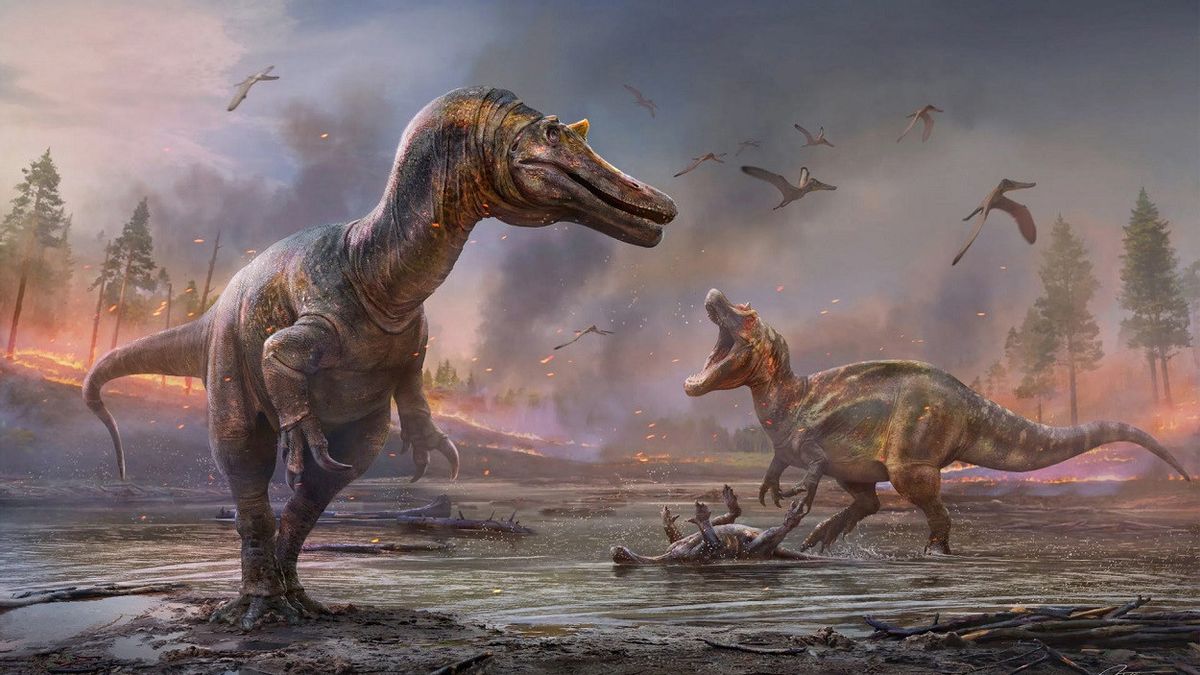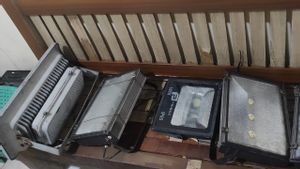JAKARTA - Fossils unearthed on a rocky coast suggest there was a double problem on the Isle of Wight, England some 127 million years ago, with a previously unknown pair of large dinosaur predators possibly coexisting, adapted to hunt along the water's edge.
Scientists on Wednesday September 29 announced the discovery of fossils from two Cretaceous meat-eaters, both measuring about 30 feet (9 meters) and an elongated skull like that of a crocodile, in the southwest of the island, one of the richest places in Europe for dinosaur remains.
They are an example of a type of dinosaur called a spinosaur, known for its long, narrow skull with many conical teeth, perfect for catching slippery fish, as well as strong arms and large claws.
One of them was named Ceratosuchops inferodios, which means 'hell crane with the face of a horned crocodile'. The name refers to the stork, due to the bird's lifestyle foraging on the shoreline. Ceratosuchops has a series of low horns and ridges that adorn its brow area.
The second is named Riparovenator milnerae, which means 'Milner riverside hunter', honoring British paleontologist Angela Milner, who died in August. It may be slightly larger than Ceratosuchops.
Each was estimated to weigh between one and two tonnes, with skulls about a yard long, according to Chris Barker, PhD student in paleontology at the University of Southampton and lead author of the study published in the journal Scientific Reports.
"Both would be shoreline hunters like storks, wading through the water and pushing their heads down quickly to grab things like fish, small turtles, etc. On land they would do the same thing, catch baby dinosaurs or something. They will. Basically eat whatever they can take," said paleontologist and study co-author David Hone of Queen Mary University of London, citing Reuters September 30.
Spinosaurs were part of a broad group of bipedal meat-eating dinosaurs called theropods, which belonged to the type Tyrannosaurus rex. As semi-aquatic hunters, spinosaurs targeted different prey and lacked the large skull, box and large serrated teeth of the T-rex, which inhabited North America some 60 million years later.
Ceratosuchops and Riparovenator explored a floodplain environment bathed in a subtropical Mediterranean-like climate. Forest fires occasionally ravage the landscape, with fossilized burnt wood found all over the cliffs of the Isle of Wight.
With large rivers and other bodies of water that attracted plant-eating dinosaurs and harbored large numbers of bony fish, sharks and crocodiles, the habitat provided Ceratosuchops and Riparovenator with plenty of hunting opportunities, Barker said.
The two cousins may have lived at the same time, may have differed in prey preferences, or may have been separated slightly in time, the researchers said. There is a third, roughly contemporaneous spinosaur named Baryonyx, whose fossils were discovered in the 1980s, that lived nearby and was about the same size, perhaps a little smaller.
Some of the remains of Ceratosuchops and Riparovenator were found near the town of Brightstone, England. Ceratosuchops is known from skull material, while Riparovenator is known from skull and tail materials. There are braincase remnants for both, providing special insight into these creatures.
The fossils helped scientists produce a family tree of spinosaurs, which suggests the lineage originated in Europe before moving to Africa, Asia and South America, according to University of Southampton paleobiologist Neil Gostling, who oversaw the research project.
The largest, Spinosaurus, was up to 50 feet (15 meters) long and lived in North Africa about 95 million years ago. It differs from its predecessor the Isle of Wight, boasting a large, sail-like structure on its back and adaptations for a more aquatic lifestyle.
The English, Chinese, Japanese, Arabic, and French versions are automatically generated by the AI. So there may still be inaccuracies in translating, please always see Indonesian as our main language. (system supported by DigitalSiber.id)













